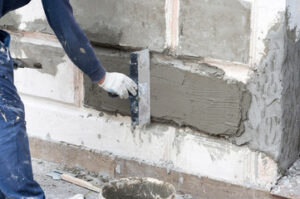J&R Construction is putting together parts to form an object or system. It is a broad field that includes many types of projects.
Each type of project requires specific skills and knowledge. It also involves working with external stakeholders, such as regulatory agencies or support staff. The construction manager is responsible for managing these relationships.

Buildings serve several purposes. They provide shelter from the elements, security and privacy, living space, and storage facilities, to name a few. While buildings may take on many forms, some basic construction principles are applied to all of them. These include structural integrity, efficiency, cost, durability, and safety. Buildings are constructed from various materials, including wood, concrete, and steel. They also come in a wide range of shapes and sizes. Some are large and high-rise, while others are smaller and more traditional.
The terms “construction” and “building” are often used interchangeably, but there is a slight difference between the two. The former is a more general term that includes any project, while the latter refers to creating a specific structure. The difference is particularly important in the construction industry, where a team’s work can be anything from erecting a new office to repairing a bridge.
There are five types of building construction, namely:
Commercial buildings are commercial structures built for business and commerce. They can be used for retail, industrial, or office space. Some examples of commercial buildings include warehouses, stores, and offices.
Educational buildings are designed and built to house educational institutions, such as schools or colleges. Government bodies, semi-government organizations, or registered trusts usually make them. Academic buildings are also known as educational institutions, Dharamshala, or boarding houses.
Storage buildings are structures used for the storage of goods and merchandise. They may also be known as garages, warehouses, or transit sheds. They are usually located in areas with good road access, such as near a port or airport.
Special buildings are structures designed and built for a specific use or particular reasons. These include assembly buildings, industrial buildings, wholesale establishments, and hazardous buildings.
Regardless of the type of building, the process of building construction starts with planning. This involves creating a blueprint, followed by constructing the actual building. The design process can be complex and time-consuming, but it is essential for the success of a project. It is also important to consider the safety of all occupants during this phase.
Infrastructure is a term used to describe the basic systems and facilities a country or organization needs to function. It includes physical systems like roads and railway networks, water supply, sewage, electrical grids, and telecommunications (including broadband Internet access). It also refers to law enforcement, healthcare, and education services.
Infrastructure investment plays a crucial role in economic development. It helps to lower the cost of goods and services, improves efficiency in production, and increases productivity. It is also an important factor in attracting investment and creating jobs.
The type of infrastructure needed varies by country or region, including hard and soft assets. Hard infrastructure consists of the physical components that support daily life, such as electrical grids and roadways. In contrast, weak infrastructure refers to social and economic elements, including education, health care, and financial institutions.
When discussing government policy proposals, it is important to define infrastructure clearly. Some politicians use the term loosely to include anything that will boost economic growth, but this can lead to unrealistic silver-bullet policies that fail to consider each infrastructure sector’s unique attributes. The Committee on Transportation and Infrastructure is responsible for approving all spending on infrastructure.
Many industries can benefit from infrastructure investment, such as energy, telecommunications, and transport networks. These industries provide essential services to consumers and businesses and are critical for a country’s competitiveness. In addition, constructing infrastructure can create new job opportunities in engineering and finance.
To make an effective infrastructure investment, it is important to consider both the short and long-term impacts. Generally, investment in infrastructure is required for several years before it can start to pay off. This means that infrastructure projects should be planned carefully to ensure they are not putting unnecessary pressure on the economy at any given time.
Many government, private, and international organizations invest in infrastructure to achieve business objectives and improve people’s lives. There are also many different career opportunities in infrastructure management and maintenance.
There are many different building materials used in construction. Some of them are natural, and some are artificial. Some of the more common ones include stone, wood, concrete, and steel. These materials are used in a wide variety of projects. Construction professionals and engineers choose the most appropriate materials for each project based on cost, strength, and durability.
Metals are used in many building applications due to low maintenance and high strength-to-weight ratios. They are also easy to cut, form, and mold. Some examples of metals commonly used in construction are steel, aluminum, and copper. Copper is popular because it is fire retardant and has good electrical conductivity. It is often used as wall cladding, facades, and window frames. Steel is versatile and can be formed into various shapes and sizes. It is very strong in compression and tension and has good elasticity. It can be used for floors, walls, and the foundation of a building. It can also be used for the structural framework of tall buildings.
Besides metals, several other natural and artificial materials are used in the construction industry. Some are natural, such as mud, rocks, and wood, while others are synthetic, like sand and concrete. Some of these materials are useful for constructing houses that meet green construction standards.
Another material that is used for construction purposes is fabric. It consists of interwoven fibers and may be engineered to have certain properties, such as flame or weather resistance. It is often used for making temporary and low-cost structures such as tents or carport canopies.
The most important thing to remember about choosing building materials is that the quality of the construction will depend on the type of material used. A construction project that uses durable and long-lasting materials will be able to stand up to the elements for many years, resulting in lower repair and maintenance costs. It is also important to consider the environmental, energy, and social costs of the materials chosen for a construction project.
Building permits are written authorizations issued by local governments to allow construction or remodeling projects performed on residential, commercial, or industrial properties. They ensure the work will be done properly, according to construction and zoning codes that protect residents’ safety and property value. Building codes are standards developed by engineers and often implemented by states, cities, or counties.
The rules governing whether or not a homeowner needs a permit can vary greatly from one community to the next. However, most communities will require a building permit for any new activity or altering an existing structure. Some examples include replacing a home’s windows, adding or removing walls, installing insulation, and running electrical, plumbing, or gas lines.
While some people may view obtaining a permit as a nuisance, it is important for anyone planning a construction project to get a permit before starting work. In addition to ensuring that the construction will be up to code, building permits allow homeowners to compare their projects with others in the area. This will enable them to choose a contractor offering the best price and quality for their construction project.
Sometimes, homeowners can skip the permit application process by hiring a licensed professional to file the necessary plans. This is a good option for homeowners who want to spend less time and money than they desire to obtain a permit. However, this is only an option for some types of construction. Some work, such as work on gas lines, is only permitted through the permit process and requires a licensed professional to file the plans.
It is also important to note that building permits do not guarantee that the work will be completed on time or according to specifications. The licenses will provide a timeline for the construction project, but it is up to the contractor to meet that deadline. In addition, the contractor will need to contact the inspection office at designated times during the project for an inspector to visit the job site and verify that the work is progressing as expected.


